
Televue APO Refractor vs Canon Supertele
This was planned to be the ultimate head to head shoot-out between a couple of serious OTAs, hopefully devoid of passions and prejudices, no visual observer fancy wording that may mean little (pin-prick stars on an inky-black backdrop!); just dispassionate imaging to tell the tale. In one corner we have the largest imaging OTA ever made by Televue, the TV 140 (5.5" aperture, 4-element modified Petzval design) and in the other corner we have the Canon 600mm/4.0L IS, the supertele that makes all birders and sports photographers drool (5.9" aperture, 17-elements). This is the closest I could get to matching apertures, premium-level quality and perhaps even prices, between a camera lens and an astro OTA. The TV 140 was manufactured in small numbers and is no longer in production. The closest sibling currently in production is the TV-NP127is, retailing at $7000, to which you will have to add the Large Field Corrector and numerous little doodads to make that OTA sing. The Canon lens retails at $7200, ready to dance. Stick these OTAs on a decent mount, an AP1200, and you have a rather impressive assembly:

Rather absurd the amounts we spend on our toys; you are looking at over $30,000 worth for the two OTAs, an $8000 DSLR and a mount. Are we actually sane? OK, the TV 140 does not belong to me. I borrowed it from our local astro club. Here is another view:

Notice that I have the star diagonal, finder scope and laser pointer mounted on the Canon lens, just to emphasize that indeed you can use a camera lens as a premium astro APO for visual observing too. But as regards questionable sanity, I normally use a C14 for the visual stuff, simply replacing that TV 140 on the tandem cradle ;-) This is how the star diagonal mates to any Canon lens. The trick is to extend back focus by sticking in a Barlow:
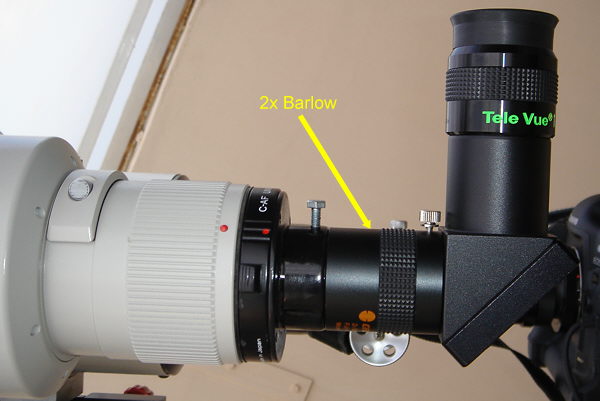
Ample details on constructing your own adapter are given here. It actually works very well and you do get a wide FoV if you employ an eyepiece with the widest-possible FoV in a 1.25" barrel. Sorry, not practical to use a 2" eyepiece. The TV 140 has been reviewed by others elsewhere, though only for visual observing. That review was based on the second scope off the production line; the one used here is Serial No. 1018, presumably the 18th sample? The TV 140 is particularly compact for a 5.5" APO, being a Petzval design, but that Canon lens is even more compact:
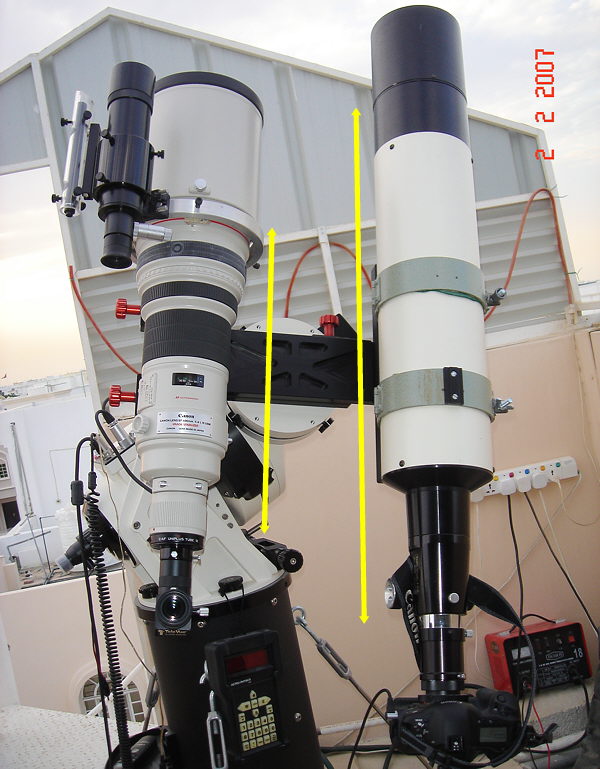
The yellow length indicators exclude the dew-shields/lens-hoods. So, how do things pan out? I first tried a shoot out in daylight and got inexplicable results, more on this later. And at night how much exposure do you give through each OTA anyway? Proportional to absolute aperture or proportional to focal ratio? I wanted to be as fair to each OTA as possible. The Moon was nearly full, so I decided to aim for the skyfog to reach the same level on the back-of-camera histogram. At ISO 800 I shot for 20sec through the TV 140 (f/5), 25sec through the Canon+1.4x tele-extender (f/5.6) and 13sec through the Canon on its own (f/4). Yes, I have heard all that stuff that stars are point sources and one should look at absolute aperture, not focal ratio. Reality is not so straightforward. While stars are point sources, they are not point images on a sensor, and focal ratio does seem to matter. Anyway, you can study the limiting magnitude with the same OTA between the crops at 840mm (25sec exposure at f/5.6) and 600mm (13sec exposure at f/4) to your heart's content and draw your own conclusions. Frames were converted Linearly from Raw and then contrast-stretched on the Brightness histogram, black-point not shifted, just the white-point shifted down drastically till the background sky gave similar readings at around 30% of full white on-axis. I tried to keep all post-processing as identical as possible. Here are the frame-wide 1:1 crops, absolute-frame-edge to absolute-frame-edge (long side) of the full 35mm-format sensor, centered on the Double Cluster in Perseus:

No lens testing is ever simple, and neither was this one. Centrally, on-axis, all the crops look quite good. Before contrast stretching they all even look fabulous! With the Canon lens I had used simple, one-click autofocus on Capella and then slewed to the Double Cluster for the imaging, with and without the 1.4x tele-extender. With the TV 140 I used ImagesPlus for focusing. The latest version has a nice focus routine that plots out FWHM as you approach focus. When we look at the edges we are in for some surprises. The TV 140 is supposed to have a large, flat image field, being a modified Petzval design. But it was produced in the days of imaging with film (a very forgiving medium in this context) and tiny CCDs. Frankly, the sides of the TV 140 frame are very disappointing, and not symmetrical either. Many possible explanations come to mind: Miss-collimation after years of field use on rough roads? Camera not dead-orthogonal to the OTA? Inherent residual field curvature? Combination of all these? Collimation should, in principle, be a non-issue for refractors, unless the OTA has experienced a hard knock, but the other issues seem to be valid, ongoing concerns. E.g. I note that for the latest TV-NP127is
The focuser has "the capability to correct for any residual focal plane tilt"
Televue offers a "Large Field Corrector for optimized edge performance on NP101is and NP127is (for big chip sizes)"
I have posted Jpegs of the above full frames elsewhere, about 0.5 megabytes each (Canon 600mm, TV 140, Canon 600mm+1.4x) just in case you wish to swim around, inspecting. I also added frames showing where you would be cropping with 1.6x crop DSLRs (Canon 30D, 400D, etc). So the above-mentioned shortcomings are not just specific to this particular TV 140, but are very likely generic to most refractors. Just because an OTA is stated to be a Petzval type does not imply that its image field is flat enough for a 35mm-format chip. Since astro-imaging has grown quite enormously in popularity and is possibly the main driver for the popularity of APOs and semi-APOs (most of which are not even Petzval types), I find it downright shameful that there are still manufacturers selling APO and semi-APO refractors without offering dedicated flatteners, especially now that large sensors are becoming so affordable, under $1000 for an APS-sized Canon or Nikon DSLR. Enough ranting for now. Of course sensor tilt also occurs with camera lenses, but it is very often of much lesser concern. Problem with many astro OTAs is that they have been designed to facilitate visual observing with constant swopping of eyepieces. For imaging one really needs a very robust, precise attachment of the camera to OTA with nil slop. Camera bayonet mounts provide this. Some premium APOs do have such precise bonds, but most do not. They rely on 2" eyepiece barrels and set screws or barrel clamping rings.
Let us now look at daytime tests. It's rather difficult to find a subject that is orthogonal, large enough to fill the frame and still be several hundred meters distant. So I shot some rooftops, and promptly found that on the edges of the frames different objects were in focus depending on whether I checked the Canon lens or the TV 140. The culprit became identified after seeing the above star fields. I repeated the daytime tests by focusing on a specific object (lens autofocus using the center focus spot only, or manual focus with the Angle Finder C with the TV 140) and then slewing without changing focus so that the object ended up at the frame edges. See the red dots on the thumbnails below:
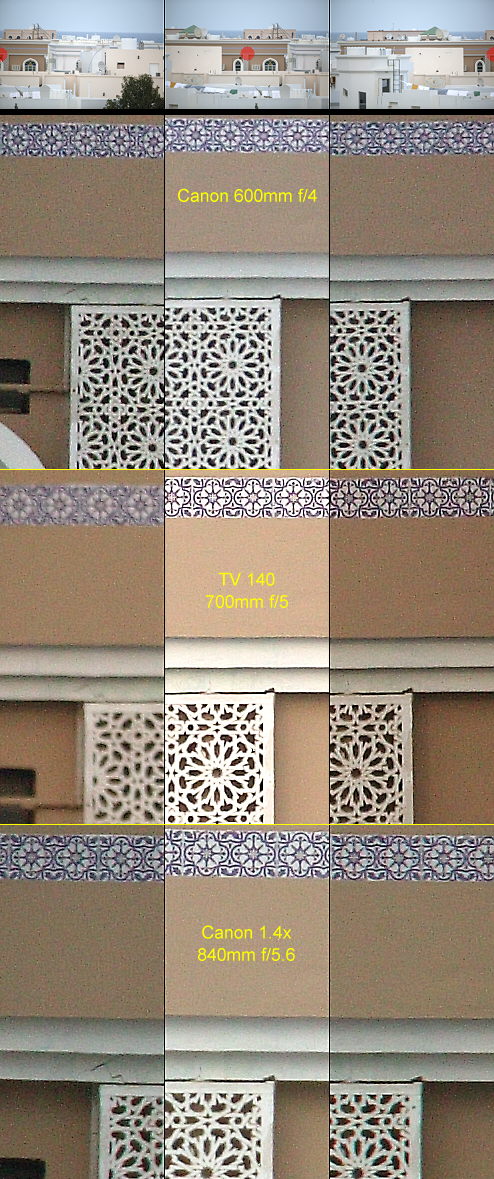
What can we conclude? The TV 140 has remarkably nice clarity/cleanliness on-axis but is poorer at the frame edges, a confirmation of the night sky results. The Canon lens has a much more even performance, apart from some slight vignetting, easily treated by flat-fielding, but it is also weaker in terms of clarity and bite, likely a reflection of the fact that it has 17 lens elements rather than just 4. So, can we demonstrate the likely superiority of the TV 140 for use as, say, a planetary scope? Saturn was high up in the sky and so I stuck on a webcam to find out. Of course I did check it out visually, but what can one say? That I saw the Cassini Division in both instruments? First note the need for an extension tube to focus the TV 140 with the DSLR, yet another possible cause of tilted sensor plane:
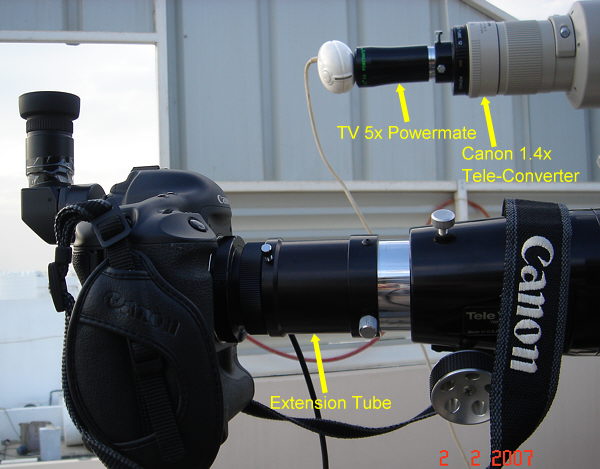
And to get the TV 140 to focus on a webcam we need yet another extension tube:

The Canon videos looked rather under-sampled when I used only the 5x Powermate, hence I employed both the 1.4x tele-converter and the Powermate in series for the final videos, to yield f/28. The TV 140 and 5x Powermate yielded a satisfactory f/27. These focal ratios were measured by calibration against The Sky planetarium software. In live mode the videos from the TV 140 did seem to have cleaner colours, but whether this got carried through to the final images, I leave that to you to judge. Hold on! Do NOT read the next paragraph yet! First try to judge which is the better image between these two, each from a different OTA, but they both received identical post-processing, apart from resizing:
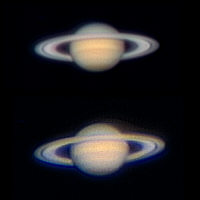
Because the OTAs had different apertures, 5.5" and 5.9", I have deliberately sized them slightly differently, in order to have a fairer comparison. I used Reverse-Nyquist sizing (2 screen pixels per theoretical FWHM of the Airy disc) in order to level the playing field. At the same planetary diameter and with equal-quality OTAs, the image from a larger aperture OTA will always look sharper. To make it look equally mushy you need to enlarge it more, ignoring seeing. I have advocated this sizing technique here. Hence the bottom Saturn is from the slightly larger aperture Canon lens. Frankly, I had never considered using this lens for planetary imaging but I see that, rather surprisingly, it does quite a decent job, competitive with the TV 140. So what happened with the on-axis clarity/cleanliness noted earlier for the TV 140? Actually, it is there but you have to search for it. Specifically, look at the colour of Saturn's Rings. The lower image (from the camera lens) has some bluish tints in both the Rings and the lower left limb of the planet itself, not so much on the upper, TV 140, image. The Crepe Ring is also more discernible on the upper image. So that APO refractor does have its good points, such as cleanliness of image (contrast) that are noticeable to those who know what to look for. For planetary webcamming we are pushing either OTA to the limits, and I expect that an IR-cut filter would do some good for either an astro APO or a camera lens. For the camera lens some kind of minus-purple filter to minimize the blue/violet halos would not go amiss. A Baader Fringe Killer should take care of both cutting IR and minimizing halos.
We have all read how APO refractors should not only deliver better-shaped stars but also higher contrast, simply because they have much fewer lens elements and are designed for a single purpose, focus at infinity. The above shoot-out confirms that they do deliver higher contrast! But also note that the camera-lens Saturn image was shot through a ridiculous 17+5+4 = 26 lens elements! And, silly me, I had forgotten to include an IR-cut filter in the imaging train. Just force of habit. For SCTs I had concluded from testing that webcamming with no IR-cut filter produced ever so slightly better results than with. The IR enables using faster exposures per frame, and SCTs do not suffer noticeable star bloat from IR. I have not confirmed that to be true for the above OTAs at the high magnifications used in planetary imaging. Sorry, you will have to do your own testing. For myself, using a DSLR for all my DSO imaging, the choice is a no-brainer. I purchase Canon lenses and auto-focus the DSLR on any bright star or planet. For visual observing and planetary webcamming I use a C14. Now that I have carried out the above shoot-out, I do not miss owning a dedicated astro APO, something about which I have had some gnawing doubts previously. And my messages for would-be purchasers of premium APO refractors for imaging purposes are:
Be skeptical as regards the claimed flatness of image fields. I understand that it is impossible to design a refractor with a flat image field that does not include rear lens elements. If the OTA does not have rear elements, and the manufacturer does not offer a specially designed field flattener, then just move on to the next manufacturer. I would not wish to stick some generic field flattener on any $5000+ OTA. When you pay many thousands of $ for your imaging OTA you expect it to be good enough for at least full 35mm format. You just may wish to upgrade next year, or soon thereafter, to that size sensor.
While sensor tilt/orthogonality may not be much of an issue for small chips, it is a major issue for 35mm format or larger. Find out what your chosen manufacturer has done about it before pulling out your credit card.
I am impressed that Televue has recognized both the above issues and now offers solutions to handle both in their current line of imaging OTAs. I suspect that with several hours of iterative trials I can get the tested TV 140 to deliver a well-centered image field on my camera, and it should then be fully satisfactory on an APS-sized chip, but I also suspect that a 35mm format chip will require a supplementary flattener.
For more stuff return to Samir's Home
To drop me an e-mail just
click on:
samirkharusi